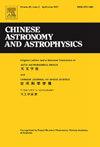用CSST/MCI鉴别系外行星透射光谱中的恒星污染
Q4 Physics and Astronomy
引用次数: 0
摘要
中国巡天望远镜(CSST)有望表征系外行星的大气,为系外行星观测提供新的机会。目前,对系外行星大气的研究多采用透射光谱法。然而,在一些观测到的透射光谱中发现了恒星活动的证据,结果表明很难准确地约束恒星污染。因此,如何准确地分辨和消除恒星污染已成为透射光谱学的主要挑战。因此,在选择后续透射光谱观测目标时,需要对潜在的恒星污染及其可区分性进行定量评估,这需要大规模的模拟来提供预期的数据。本文采用多色光度法结合机器学习识别系外气体行星透射光谱中潜在的恒星污染,并为CSST多通道成像仪(MCI)设计了一种精度最高的恒星污染识别滤波器组合,为后续系外行星大气目标观测提供了观测策略的选择。本文章由计算机程序翻译,如有差异,请以英文原文为准。
Discrimination of Stellar Contamination in Exoplanet Transmission Spectra with CSST/MCI
The Chinese Survey Space Telescope (CSST) is expected to characterize the atmospheres of exoplanets, providing new opportunities for exoplanet observations. At present, the atmospheres of exoplanets have mostly been studied by transmission spectroscopy. However, evidence of stellar activity has been found in several observed transmission spectra, and the results show that it is difficult to accurately constrain the stellar contamination. Therefore, how to accurately distinguish and eliminate stellar contamination has become a major challenge in transmission spectroscopy. Consequently, a quantitative assessment of the potential stellar contamination and its distinguishability is required when selecting targets for follow-up transmission spectroscopy observations, which requires large-scale simulations to provide the expected data. Here we use multi-color photometry combined with machine learning to identify potential stellar contamination in the transmission spectra of extrasolar gas planets, and design a filter combination with the highest accuracy for stellar contamination discrimination for the CSST Multi-Channel Imager (MCI), which can provide options for developing observing strategies for follow-up observations of exoplanet atmospheric targets.
求助全文
通过发布文献求助,成功后即可免费获取论文全文。
去求助
来源期刊

Chinese Astronomy and Astrophysics
Physics and Astronomy-Astronomy and Astrophysics
CiteScore
0.70
自引率
0.00%
发文量
20
期刊介绍:
The vigorous growth of astronomical and astrophysical science in China led to an increase in papers on astrophysics which Acta Astronomica Sinica could no longer absorb. Translations of papers from two new journals the Chinese Journal of Space Science and Acta Astrophysica Sinica are added to the translation of Acta Astronomica Sinica to form the new journal Chinese Astronomy and Astrophysics. Chinese Astronomy and Astrophysics brings English translations of notable articles to astronomers and astrophysicists outside China.
 求助内容:
求助内容: 应助结果提醒方式:
应助结果提醒方式:


